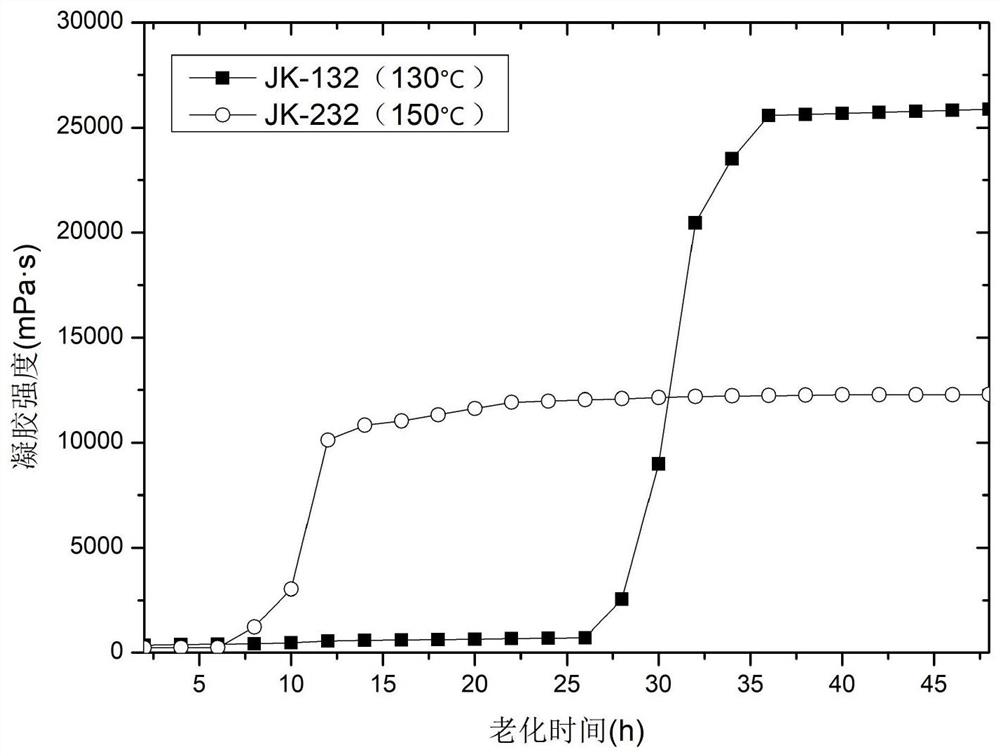Nanocomposite polymer and temperature-resistant and salt-resistant profile control agent containing the same
A nano-composite, temperature-resistant and salt-resistant technology, applied in drilling compositions, chemical instruments and methods, etc., can solve the problem of inability to achieve high temperature long-term aging, inability to endure hydrolysis and degradation, and loss of oilfield profile control and water shutoff operations. and other problems, to achieve the effect of improving strength, strong hydrolysis resistance, strong stability and temperature resistance and salt resistance
- Summary
- Abstract
- Description
- Claims
- Application Information
AI Technical Summary
Problems solved by technology
Method used
Image
Examples
preparation example Construction
[0057] Further, the preparation method of the temperature-resistant and salt-resistant profile control agent comprises the following steps:
[0058] Calculated by mass percentage, 0.5-0.8% of the nanocomposite polymer, 0.3-0.6% of the crosslinking agent, 0.05-0.2% of the heat stabilizer and the balance of water are uniformly mixed to obtain the obtained product.
Embodiment 1
[0060] Preparation of nanocomposite polymer JNP-1:
[0061] In a 1L beaker, add 556.0g of deionized water, turn on the mechanical stirring to 1000rpm, and slowly drop 1.2g of titanium dioxide nanosol into the water to form a dispersion. Then add 110.0g acrylic acid, 90.0g 2-acrylamide-2methylpropanesulfonic acid, 23.6g N-vinylpyrrolidone, 11.3g N-isopropylacrylamide, add 14.3g urea, 1.2g dodecylbenzenesulfonic acid Sodium and 0.2g isopropanol, stir to dissolve fully. When the temperature is controlled at 20°C, the above-mentioned mixed solution is then transferred into a 1L polymerization bottle, nitrogen is introduced for deoxygenation for 30min, 5ml of potassium persulfate solution with a prepared mass percentage of 1% is added, and 5ml of a prepared mass percentage of 1% is added. 2% sodium bisulfite solution, 3.5ml of 2% azodiisobutylamidine hydrochloride solution prepared by mass, seal the polymerization bottle, wait for the reaction for 6h, take out the glue block, gran...
Embodiment 2
[0063] Preparation of nanocomposite polymer JNP-2:
[0064] In a 1L beaker, add 550.0 g of deionized water, turn on the mechanical stirring to 1000 rpm, and slowly drop 1.5 g of alumina nanosol into the water to form a dispersion. Then add 106.0g acrylamide, 90.0g 2-acrylamide-2methylpropanesulfonic acid, 12.8g N-tert-butylacrylamide, 22.8g N-vinylpyrrolidone, add 15.5g urea, 2.4g sodium dodecyl sulfate And 0.8g tert-butanol, stir and dissolve fully. When the temperature is controlled at 25°C, the above mixture is then transferred to a 1L polymerization bottle, nitrogen is introduced for deoxygenation for 30min, 6ml of sodium persulfate solution with a mass percentage of 1% is added, and 6ml of a prepared mass percentage of 1% is added. 2% sodium sulfite solution and 4ml of prepared 2% azobisisobutyronitrile solution by mass, seal the polymerization bottle, wait for 4 hours to react, take out the glue block, granulate, dry, pulverize and sieve to obtain nanocomposite polymeri...
PUM
| Property | Measurement | Unit |
|---|---|---|
| viscosity | aaaaa | aaaaa |
Abstract
Description
Claims
Application Information
 Login to View More
Login to View More - R&D
- Intellectual Property
- Life Sciences
- Materials
- Tech Scout
- Unparalleled Data Quality
- Higher Quality Content
- 60% Fewer Hallucinations
Browse by: Latest US Patents, China's latest patents, Technical Efficacy Thesaurus, Application Domain, Technology Topic, Popular Technical Reports.
© 2025 PatSnap. All rights reserved.Legal|Privacy policy|Modern Slavery Act Transparency Statement|Sitemap|About US| Contact US: help@patsnap.com



